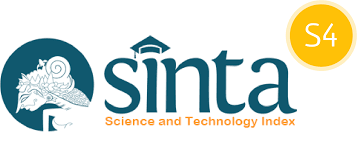Growth and Polyphenols Content of Kale In Growing Media With Humic Acid Addition
Abstract
Kale (Brassica oleracea) contains some nutritional values like: vitamin C, pro vitamin A (carotenoids), and some compound belong to polyphenol are flavonoids that benefit to its consumer for the growth and health of the body. Polyphenols are bioactive molecules which play an essential role in plants response to ultraviolet irradiation, and high temperature. Flavonoids comprise the most studied group of polyphenols. This group has a common basic structure consisting of two aromatic rings bound together by three carbon atoms that form an oxygenated heterocycle. In order to support growth and increase it’s productivity, cultivation of Kale supposed to be done in good planting media. The addition of organic subtances like humic acid in planting media has proven to increase plant growth and increase productivity in several plants. The objectives of this research were to know the influence of the influence of humic acid on the growth of plant varieties and polyphenol content and to determine the best concentration of humic acid in increasing growth and polyphenol content. The current research method was carried out experimentally a completely randomize design in a split plot method. The main plot was plant’s varieties in 2 levels: V1: Kale Nero toscana (Brassica oleracea var. palmifolia), V2: Siberian dwarf Kale (Brassica oleracea Var. Sabellica). while the sub plot was the HA concentrations in 4 levels i.e 0 g.kg-1, 4 g.kg-1, 8 g.kg-1, and 12 g.kg-1 of planting medium, The parameters used in this study are fresh and dry weight. These data were obtained by weighing the roots and shoots; root’s length, chlorophyll content, and polyphenol content in kale. The data of polyphenol content was obtained by extracting the plant material following a maceration method then calculated using the Folin ciochalteau spectrophotometric. The data of plant’s growth and polyphenol content obtained was analyzed using (F test) with standard deviation rate of 5% and 1%. The results of the analysis of variance which has a significant different, followed by the least significant difference test (LSD). And for the result is the treatment of humic acid increase the growth and polyphenol content of Kale Nero (B. oleracea var. Palmifolia) and Siberian dwarf kale (B. oleracea Var. Sabellica).
References
Cartea, M.E., Francisco, M., Soengas, P. & Velasco, P., 2011. Phenolic compounds in Brassica vegetables. Molecules, 16(1), pp.251-280.
Dhianawaty, D., 2015. Kandungan Total Polifenol dan Aktivitas Antioksidan dari Ekstrak Metanol Akar Imperata cylindrica (L) Beauv.(Alang-alang). Majalah Kedokteran Bandung, 47(1), pp.60-64.
Fauziah, I., Proklamasiningsih, & E., Budisantoso, I., 2019. Pengaruh Asam Humat pada Media Tanam Zeolit terhadap Pertumbuhan dan KandunganVitamin C Sawi Hijau (Brassica juncea). Jurnal Ilmiah Biologi Unsoed. 1(2), pp 17-21.
Hagen, S.F., Borge, G.I.A., Solhaug, K.A., & Bengtsson, G.B., 2009. Effect of cold storage and harvest date on bioactive compounds in curly kale (Brassica oleracea L. var. acephala). Postharvest Biology and Technology, 51(1), pp.36-42.
Heimler, D., Vignolini, P., Dini, M.G., Vincieri, F.F., & Romani, A., 2006. Antiradical activity and polyphenol composition of local Brassicaceae edible varieties. Food chemistry, 99(3), pp.464-469.
Julianto, S. T., 2019. Fitokimia Tinjauan Metabolit Sekunder dan Skrining Fitokimia. Yogyakarta: Universitas Islam Indonesia.
Khaled, H. & Fawy, H.A., 2011. Effect of different levels of humic acids on the nutrient content, plant growth, and soil properties under conditions of salinity. Soil and Water Research, 6(1), pp.21-29.
Kurniyanti, R., Budiman, B., & Surtani M.,2010. Pengaruh Media dan Naungan Terhadap Mutu Bibit Suren (Toona sureni MERR.). Jurnal Penelitian Hutan Tanaman, 7(2), pp. 77-83
Lakitan, B. 2007. Dasar-dasar Fisiologi Tumbuhan. Cetakan Pertama. PT Raja Grafindo Persada, Jakarta.
Latifa, R., Hadi, S., & Nurrohman, E. (2019). The Exploration of Chlorophyll Content of Various Plants in City Forest of Malabar Malang. BIOEDUKASI: Jurnal Biologi dan Pembelajarannya, 17(2), pp.50-62.
Nuraini, Y., & Zahro, A., 2020. Pengaruh Aplikasi Asam Humat Dan Pupuk Npk Phonska 15-15-15 Terhadap Serapan Nitrogen Dan Pertumbuhan Tanaman Padi Serta Residu Nitrogen Di Lahan Sawah. Jurnal Tanah dan Sumberdaya Lahan, 7(2), pp 195-200.
Pandey, K. B., & Rizvi, S. I. 2009. Plant polyphenols as dietary antioxidants in human health and disease. Oxidative medicine and cellular longevity, 2(5), 270-278.
Proklamasiningsih, E., Budisantoso, I., & Maula, I., 2019. Pertumbuhan dan Kandungan Polifenol Tanaman Katuk (Sauropus androgynus (L.) Merr) pada Media Tanam Dengan Pemberian Asam Humat. Al-Kauniyah: Jurnal Biologi, 12(1), pp.96-102.
Rahmandhias, D.T. & Rachmawati, D., 2020. Pengaruh Asam Humat terhadap Produktivitas dan Serapan Nitrogen pada Tanaman Kangkung Darat (Ipomoea reptans Poir.). Jurnal Ilmu Pertanian Indonesia, 25(2).
Ridwan, A., Astrian, R.T. & Barlian, A., 2012. Pengukuran efek antidiabetes polifenol (polyphenon 60) berdasarkan kadar glukosa darah dan histologi pankreas mencit (Mus musculus l.) sw jantan yang dikondisikan diabetes mellitus. Jurnal Matematika dan Sains, 17(2), pp.78-82.
Salim, Milana, Y. & Sitorus, H., 2012. Hubungan Hara Tanah Dengan Produksi Senyawa Metabolit Sekunder Pada Tanaman Duku (Lansium domesticum Corr va Duku) Dan Potensi Sebagai Larvasida. Jurnal Vektor Penyakit, 10(1), pp.11-18.
Salisbury F.B. & Ross.C.W.1992. Fisiologi Tumbuhan. Jilid I. Cetakan Keempat. Penerbit ITB, Bandung.
Singla, R. K., Dubey, A. K., Garg, A., Sharma, R. K., Fiorino, M., Ameen, S. M., & Al-Hiary, M. 2019. Natural polyphenols: chemical classification, definition of classes, subcategories, and Structures. Journal of AOAC INTERNATIONAL, 102 (5), pp.1397-1400.
Selim, E.M., Shedeed, S.I., Asaad, F.F., & El-Neklawy, A.S., 2012. Interactive effects of humic acid and water stress on chlorophyll and mineral nutrient contents of potato plants. Journal of Applied Sciences Research, (1), pp.531-537.
Setyanti, Y. H., Anwar, S., & Slamet, W. 2013. Karakteristik fotosintetik dan serapan fosfor hijauan alfalfa (Medicago sativa) pada tinggi pemotongan dan pemupukan nitrogen yang berbeda. Animal Agriculture Journal, 2(1), pp. 86-96.
Susilawati, S., Wardah, W., & Irmasari, I. 2016. Pengaruh berbagai Intensitas Cahaya terhadap Pertumbuhan Semai Cempaka (Michelia champaca L.) di Persemaian. ForestSains, 14(1), 59-66.
Syaifuddin, 2015. Uji Aktivitas Antioksidan Bayam Merah (Alternanthera amoena Voss.) Segar Dan Rebus Dengan Metode DPPH. Skripsi. Semarang: UIN Walisongo.
Setiari, N. and Nurchayati, Y., 2009. Eksplorasi kandungan klorofil pada beberapa sayuran hijau sebagai alternatif bahan dasar food supplement. Bioma, 11(1), pp.6-10.
Yildirim, E., 2007. Foliar and soil fertilization of humic acid affect productivity and quality of tomato. Acta Agriculturae Scandinavica Section B-Soil and Plant Science, 57(2), pp.182-18
Yosepa, T., Siregar, C. & Gusmayanti, E., 2013. Pengaruh penggunaan jenis media terhadap aklimatisasi anggrek Dendrobium Sp (Hibrida) Doctoral dissertation: Tanjungpura University.














_copy.png)



